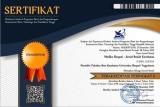PICKY EATER, ASUPAN MAKAN, DAN STATUS GIZI PADA ANAK PRASEKOLAH
DOI:
https://doi.org/10.35842/mr.v17i2.645Keywords:
picky eater, asupan makan, status gizi, anak prasekolah, usia 3-5 tahunAbstract
Latar belakang: Picky eater dapat menyebabkan asupan makan tidak mencukupi kebutuhan. Apabila berlangsung lama, maka dapat mempengaruhi status gizi. Berat badan anak dapat menjadi kurang, dan berdampak pada pertumbuhan dan perkembangannya. Tujuan: untuk menganalisis hubungan picky eater dengan asupan makan dan status gizi pada anak prasekolah. Metode: Sejumlah 139 anak usia 3-5 tahun dari 12 posyandu di Kota Malang diikutkan dalam penelitian cross-sectional ini menggunakan purpossive sampling. Status picky eater ditentukan berdasarkan Children’s Eating Behaviour Questionnaire (CEBQ), sedangkan asupan makan (energi, protein, seng) dikumpulkan menggunakan food recall 3x24 jam. Status gizi ditentukan menggunakan parameter BB/U. Perbedaan status gizi pada anak berdasarkan status picky eater dianalisa menggunakan uji Kolmogorov Smirnov, sedangkan perbedaan asupan makan diuji menggunakan uji Mann-Whitney. Hasil: Sebanyak 12,2% anak mengalami picky eater dan 1,4% anak mengalami gizi buruk. Tidak ada perbedaan asupan makan dan status gizi pada anak picky eater dengan yang tidak picky eater (p>0,05). Kesimpulan: Tidak ada perbedaan yang bermakna pada asupan makan dan status gizi antara anak picky eater dengan yang tidak. Meskipun demikian, terdapat kecenderungan anak picky eater memiliki status gizi yang lebih kurang disbanding anak yang tidak picky eaterReferences
Brown, C. L., Perrin, E. M., Peterson, K. E., Brophy Herb, H. E., Horodynski, M. A., Contreras, D., … Lumeng, J. C. (2018). Association of Picky Eating With Weight Status and Dietary Quality Among Low-Income Preschoolers. Academic Pediatrics, 18(3), 334–341. https://doi.org/10.1016/j.acap.2017.08.014
Cerdasari, C., Helmyati, S., & Julia, M. (2017). Tekanan untuk makan dengan kejadian picky eater pada anak usia 2-3 tahun. Jurnal Gizi Klinik Indonesia, 13(4), 170. https://doi.org/10.22146/ijcn.24169
Chao, H. (2018). Association of Picky Eating with Growth, Nutritional Status, Development, Physical Activity, and Health in Preschool Children. Frontiers in Pediatrics, 6(February), 1–9. https://doi.org/10.3389/fped.2018.00022
Chilman, L., Kennedy-Behr, A., Frakking, T., Swanepoel, L., & Verdonck, M. (2021). Picky eating in children: A scoping review to examine its intrinsic and extrinsic features and how they relate to identification. International Journal of Environmental Research and Public Health, 18(17). https://doi.org/10.3390/ijerph18179067
Clare E. Holley, Haycraft, E., & Farrow, C. (2020). Unpacking the relationships between positive feeding practices and children’s eating behaviours: The moderating role of child temperament. Appetite, 147(104548).
Cosmi, V. De, Scaglioni, S., & Agostoni, C. (2017). Early Taste Experiences and Later Food Choices, 1–9. https://doi.org/10.3390/nu9020107
Dinas Kesehatan Kota Malang. (2014). Profil Kesehatan Kota Malang Tahun 2013. Malang.
Emmett, P. M., Hays, N. P., & Taylor, C. M. (2018). Antecedents of picky eating behaviour in young children. Appetite, 130(April), 163–173. https://doi.org/10.1016/j.appet.2018.07.032
Gan, K., Tithecott, C., Neilson, L., Seabrook, J. A., & Dworatzek, P. (2021). Picky Eating Is Associated with Lower Nutrient Intakes from, 1–16.
Grulilchova, M., Kuruczova, D., Svancara, J., Pikhart, H., & Bienertova-Vasku, J. (2022). Association of Picky Eating with Weight and Height — The European Longitudinal Study of Pregnancy and Childhood (ELSPAC-CZ). Nutrients, 14(444), 1–9.
Hardianti, R., Dieny, F. F., & Wijayanti, H. S. (2018). Picky eating dan status gizi pada anak prasekolah. Jurnal Gizi Indonesia (The Indonesian Journal of Nutrition), 6(2), 123–130. https://doi.org/10.14710/jgi.6.2.123-130
Jansen, P. W., Derks, I. P. M., Mou, Y., van Rijen, E. H. M., Gaillard, R., Micali, N., … Hillegers, M. H. J. (2020). Associations of parents’ use of food as reward with children’s eating behaviour and BMI in a population-based cohort. Pediatric Obesity, 15(11), 1–10. https://doi.org/10.1111/ijpo.12662
Lwanga, S. K., & Lemeshow, S. (1991). Sample Size Determination in Health Studies. England: World Health Organization.
Paroche, M. M., Caton, S. J., Vereijken, C. M. J. L., Weenen, H., & Houston-Price, C. (2017). How infants and young children learn about food: A systematic review. Frontiers in Physiology, 8(JUL). https://doi.org/10.3389/fpsyg.2017.01046
Patel, M. D., Donovan, S. M., & Lee, S. Y. (2020). Considering nature and nurture in the etiology and prevention of picky eating: A narrative review. Nutrients, 12(11), 1–18. https://doi.org/10.3390/nu12113409
Putri, A. N., & Muniroh, L. (2019). Hubungan Perilaku Picky eater dengan Tingkat Kecukupan Zat Gizi dan Status Gizi Anak Usia Prasekolah Di Gayungsari. Amerta Nutrition, 3(4), 232. https://doi.org/10.20473/amnt.v3i4.2019.232-238
Rahill, S., Kennedy, A., Walton, J., McNulty, B. A., & Kearney, J. (2019). The factors associated with food fussiness in Irish school-aged children. Public Health Nutrition, 22(1), 164–174. https://doi.org/10.1017/S1368980018002835
Rohde, J. F., Händel, M. N., Stougaard, M., Olsen, N. J., Trñrup, M., Mortensen, E. L., & Heitmann, B. L. (2017). Relationship between pickiness and subsequent development in body mass index and diet intake in obesity prone normal weight preschool children. PLoS ONE, 12(3), 1–9. https://doi.org/10.1371/journal.pone.0172772
Suresh, K., & Chandrashekara, S. (2012). Sample size estimation and power analysis for clinical research studies. Journal of Human Reproductive Sciences, 5(1), 7–13.
Taylor, C. M., & Emmett, P. M. (2020). Europe PMC Funders Group Picky eating in children : causes and consequences. Proc Nutr Soc, 1–9. https://doi.org/10.1017/S0029665118002586.
Tharner, A., Jansen, P. W., Jong, J. C. K., Moll, H. A., Ende, J. Van Der, Jaddoe, V. W. V, … Franco, O. H. (2014). Toward an operative diagnosis of fussy / picky eating : a latent profile approach in a population-based cohort. International Journal of Behavioral Nutrition and Physical Activity, 11(14), 1–11. https://doi.org/10.1186/1479-5868-11-14
Volger, S., Sheng, X., Tong, L. M., Zhao, D., Fan, T., Zhang, F., … Yao, M. (2017). Nutrient intake and dietary patterns in children 2.5-5 years of age with picky eating behaviours and low weight-for-height. Asia Pacific Journal of Clinical Nutrition, 26(1), 104–109. https://doi.org/10.6133/apjcn.102015.02
Wolstenholme, H., Kelly, C., Hennessy, M., & Heary, C. (2020). Childhood fussy/picky eating behaviours: A systematic review and synthesis of qualitative studies. International Journal of Behavioral Nutrition and Physical Activity, 17(1), 1–22. https://doi.org/10.1186/s12966-019-0899-x
Yaqob Qazaryan, K. S., & Kazim Karim, S. (2019). The clinical link of preschoolers’ picky eating behavior with their growth, development, nutritional status, and physical activity in Iraq/Kurdistan region. Neurology and Neuroscience Reports, 2(1). https://doi.org/10.15761/nnr.1000115




